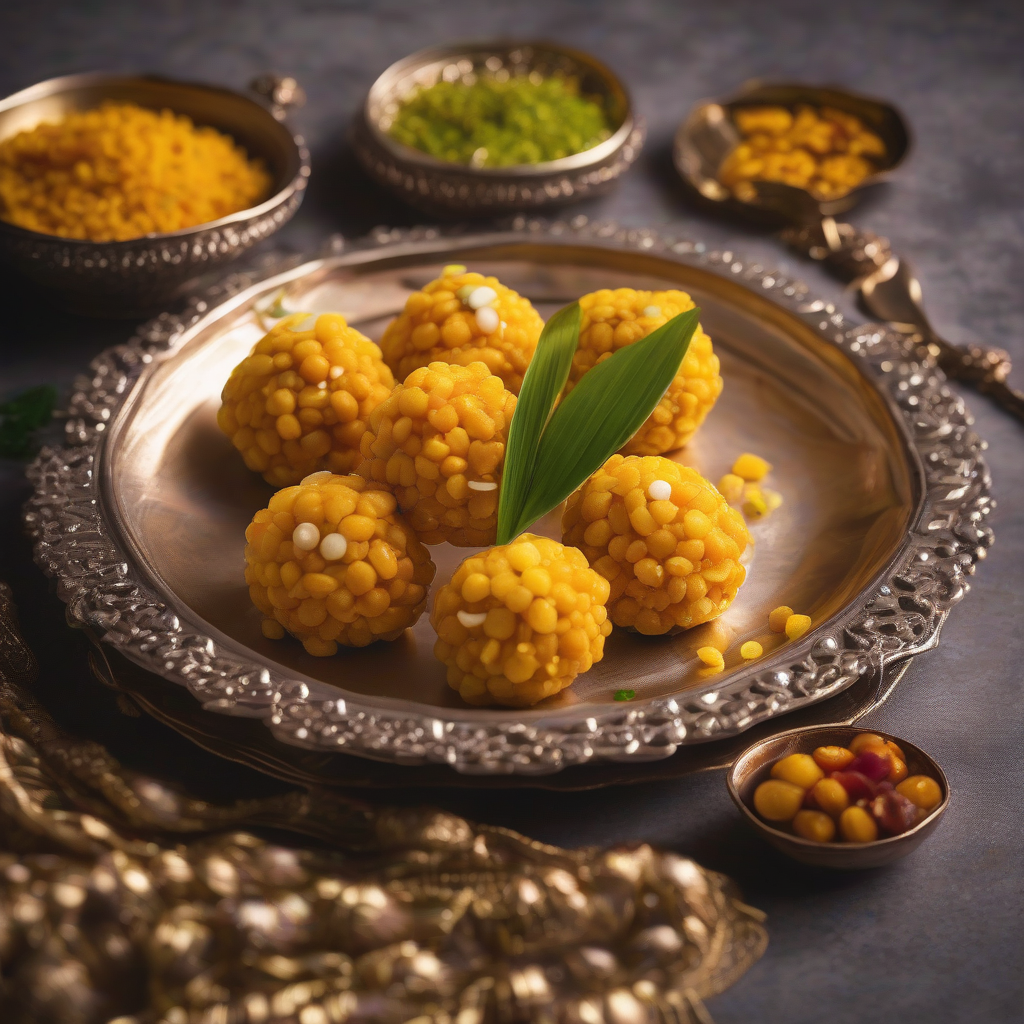Mithaas Bhara Pyaar: Pahari Boondi Laddu – A Sweet Symphony from the Hills!
Namaste and Pranam folks! Chef Curry Do’pyaza here, back in your kitchens and hearts with another delectable dish straight from the heartland of India. Today, we’re taking a trip to the serene, breathtaking hills for a taste of Pahari Boondi Laddu – a sweet treat that’s as heartwarming as a cozy fire on a chilly mountain night.
Now, for my Pahari brothers and sisters, a big Jai Mata Di to you all! This laddu is more than just a sweet; it’s a symbol of our vibrant culture and traditions.
Occasions for Sweetness
These golden spheres of joy are especially popular during festive occasions like Diwali, Dussehra, and weddings. They’re also a common offering in temples and a delightful treat to share with loved ones during the winter months when the air is crisp and the heart yearns for something warm and comforting. Think of it as sunshine captured in a sweet, round form!
A Glimpse into History
While the exact origins are shrouded in mystery, Boondi Ladoo has been a beloved sweet in India for centuries. The Pahari version, with its unique texture and subtle flavors, is a testament to the ingenuity of the people living in the Himalayan region. They’ve perfected the art of using simple ingredients to create something truly special.
Let’s Get Cooking!
Alright, enough chit-chat! Let’s get our hands floury and create some magic. Here’s what you’ll need:
Preparation Time: 15 minutes
Cooking Time: 45 minutes
Ingredients:
- Besan (Gram Flour): 2 cups
- Ghee (Clarified Butter): For frying + 2 tablespoons
- Cheeni (Sugar): 1 ½ cups
- Pani (Water): ¾ cup + ½ cup
- Elaichi Powder (Cardamom Powder): ½ teaspoon
- Kesar (Saffron Strands): A pinch, soaked in 2 tablespoons of warm milk (optional, for that extra touch of luxury!)
- Badam (Almonds): 1/4 cup, chopped (optional, for a delightful crunch)
- Kharbooja Beej (Melon Seeds): 2 tablespoons (optional, for a nutty flavor)
Step-by-Step Instructions:
- The Batter is Key: In a large bowl, whisk together the besan and ¾ cup of water until you have a smooth, lump-free batter. It should be of a flowing consistency, like a thin pancake batter. Let it rest for 15 minutes. This allows the besan to absorb the water properly.
- Sweet Symphony Syrup: While the batter rests, let’s make the sugar syrup. In a heavy-bottomed pan, combine the cheeni and ½ cup of water. Heat over medium heat, stirring constantly until the sugar dissolves completely.
- One-String Consistency: Continue to cook the syrup until it reaches a “one-string consistency.” To test this, take a small drop of syrup between your thumb and index finger. When you pull them apart, a single, thin string should form. Add the elaichi powder and saffron milk (if using) to the syrup. Keep the syrup warm on low heat.
- Boondi Bonanza: Heat ghee in a deep frying pan or kadai over medium heat. The ghee should be hot enough that a drop of batter sizzles and rises to the surface quickly.
- The Magic Ladle: Hold a perforated spoon (a jhara) about 4-6 inches above the hot ghee. Pour a ladleful of batter onto the jhara. Gently tap the jhara so that small droplets of batter fall into the ghee. These droplets are your boondi!
- Golden Goodness: Fry the boondi until they are lightly golden and crisp. Don’t overcrowd the pan; fry in batches.
- Syrupy Embrace: Remove the fried boondi with a slotted spoon and immediately add them to the warm sugar syrup. Stir gently to coat them evenly.
- Rest and Absorb: Let the boondi soak in the syrup for about 20-30 minutes, allowing them to absorb all that sweet goodness.
- Laddu Formation: Add the chopped almonds and melon seeds (if using) to the boondi mixture. Mix well.
- Shape and Serve: Grease your palms with a little ghee. Take a portion of the boondi mixture and gently roll it into a round laddu shape. Repeat with the remaining mixture.
- Cool and Enjoy: Allow the laddus to cool completely before serving.
Chef’s Tips for Laddu Perfection:
- Batter Consistency: The batter is crucial. If it’s too thick, the boondi will be flat. If it’s too thin, they’ll be misshapen.
- Ghee Temperature: The ghee should be hot enough, but not smoking.
- Don’t Overcrowd: Fry the boondi in batches to ensure they cook evenly.
- Syrup Consistency: The one-string consistency is vital for the laddus to hold their shape.
Different Cooking Methods:
- Gas Stove: The traditional and most common method, as described above.
- Induction Stove: Works perfectly well; just adjust the heat settings accordingly.
- Air Fryer: You can bake the boondi in an air fryer. Set the temperature to 350°F (175°C) and bake for 8-10 minutes, flipping halfway through. This method requires less ghee.
- Oven: You can bake the boondi in an oven. Set the temperature to 350°F (175°C) and bake for 10-12 minutes, flipping halfway through. This method requires less ghee.
Nutritional Information (approximate, per laddu):
- Calories: 150-200
- Fat: 8-10g
- Carbohydrates: 20-25g
- Protein: 2-3g
Serving Suggestions:
- Serve these delightful laddus as a sweet treat after a meal.
- Offer them as prasad during religious ceremonies.
- Pack them as a snack for picnics or road trips.
- Enjoy them with a hot cup of chai on a cold evening.
A Sweet Call to Action:
Now, my dear friends, it’s your turn! Roll up your sleeves, gather your ingredients, and bring the flavors of the Pahari hills into your own kitchens. Try this recipe, and I promise you won’t be disappointed. Share these laddus with your friends and family, and spread the joy of homemade goodness. Let me know how it goes, and keep cooking with love!
Until next time, Khana banao, khush raho! (Cook food, be happy!)
